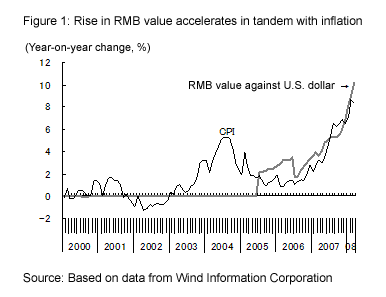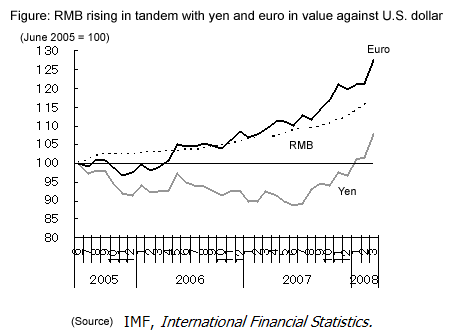Following a shift from a de facto dollar-peg to a "managed floating" exchange rate in July 2005, the renminbi (RMB) has been trending upward against the U.S. dollar, breaking the 7-yuan threshold on April 10, 2008. This represents an 18% increase from 8.28 yuan, the level right before the shift to the managed floating system. The rise has been accelerating particularly since 2007 and the value of the RMB at the end of March 2008 marked a 10% increase from a year before. This indicates the policy stance of the People's Bank of China (PBOC, China's central bank) to control rising inflation by allowing the RMB to appreciate faster (Figure 1). In addition, the weak U.S. dollar, which has been falling sharply not only against the RMB but other major currencies, is spurring the RMB's rise against it (box).

Despite the shift to the managed floating system, the emphasis has remained on the management rather than the floating of the RMB. Therefore, the movement of the Chinese currency has been affected more by the PBOC's stance than by the supply-demand relationship in the market. However, with the actual exchange rate of the RMB kept low relative to its equilibrium rate, speculative funds are flowing into China; an additional factor, on top of actual demand, in increased upward pressure on the RMB. Concerned about the potential negative impacts of the rapidly strengthening RMB on exports and employment, the PBOC has been trying to slow the pace of appreciation through market interventions in the form of buying U.S. dollars and selling RMB.
However, an expansion of the money supply (liquidity) resulting from interventions in the foreign exchange market has spurred inflation. The consumer price index (CPI) for the first quarter of 2008 marked 8.0%, the highest in almost 12 years. Accelerated inflation could lead to social instability, as with the Tiananmen Square incident of 1989. Controlling inflation has thus become a top priority issue for the Chinese government.
As a means of controlling inflation, the PBOC has implemented a series of tightening measures including raising interest rates. But these measures have yet to produce the desired outcomes as the effectiveness of monetary policy is significantly constrained by the current foreign exchange policy which focuses on the RMB's stability against the dollar, amid increasing capital mobility. Given the downward trend of overseas interest rates, particularly in the United States, any attempt to raise interest rates in China will trigger massive capital inflows in pursuit of higher returns, further driving liquidity expansion. With inflation rising faster than nominal exchange rates, real interest rates have been kept relatively low for residents in China, but for overseas investors higher interest rates combined with an expectation of a further appreciation of the RMB promise extremely favorable returns on investment in the RMB. China, in official terms, has been strictly regulating capital inflows and outflows, but such regulations are in fact becoming ineffective.
Against such a backdrop, the PBOC has begun to focus on appreciation of the RMB, instead of raising interest rates, as a means of controlling inflation. A trade-off relationship exists between the degree of RMB appreciation and the scale of interventions in the foreign exchange market. Thus, allowing the RMB to appreciate faster suppresses the scale of market intervention and the resulting increased money supply. At the same time, although the prices of crude oil and other natural resources, the supply of which China heavily relies on imports, have been increasing sharply in dollar terms, the rise in RMB-denominated prices would be moderated if the Chinese currency is allowed to strengthen against the dollar. On the other hand, an appreciation of the RMB would increase expectations for further appreciation, which, as in the case of interest rate hikes, could lead to further increases in speculative capital inflows and a surge in liquidity, partly offsetting its expected inflation-curbing effect.
In order to increase the effectiveness of monetary policy as a means of controlling inflation, the PBOC ultimately needs to stop market interventions and completely let the market determine RMB exchange rates. That is, China must shift from its current managed floating system to a "free floating" system. There is concern that this would cause a sharp rise in the RMB and deal a huge blow to China's exports. However, due to the RMB's strengthening to date, China's trade surplus has already begun to shrink and room for a further rise in RMB value is narrowing. In the future, as upward pressure on the RMB decreases with further shrinking of China's trade surplus, China will have a golden opportunity to shift to a free floating exchange rate system.
Box: Increasing tendency of RMB to synchronize with yen and euro
The RMB has been rising in tandem with the yen and euro against the U.S. dollar (figure). Presumably, this reflects China's adopting a currency basket system in which the weights of the yen and euro, apart from that of the dollar, are kept relatively high. A regression analysis of monthly data from January 2007 onward, which assumes that the PBOC determines RMB exchange rates by referencing the dollar-yen-euro currency basket in addition to the inflation rate, has found that the yen and euro are given a weight of slightly less than 20% each, with the remaining some 60% being assigned to the dollar, and that a 1% rise in the inflation rate would increase the RMB's value against the U.S. dollar by an estimated 0.49%.



